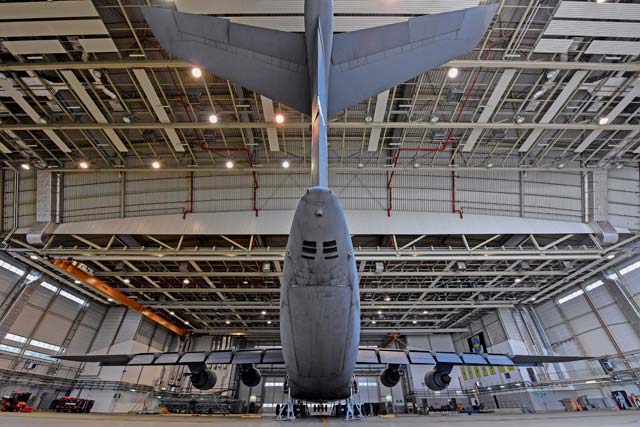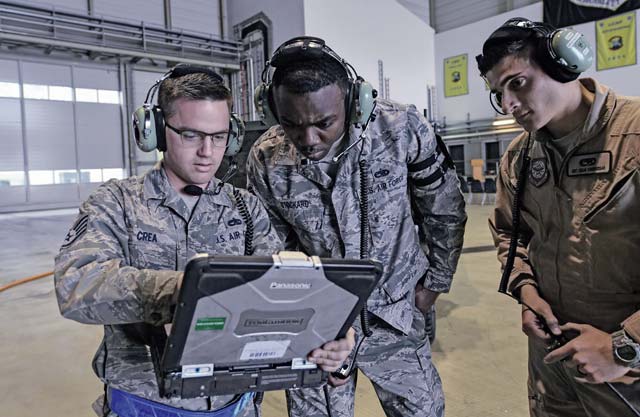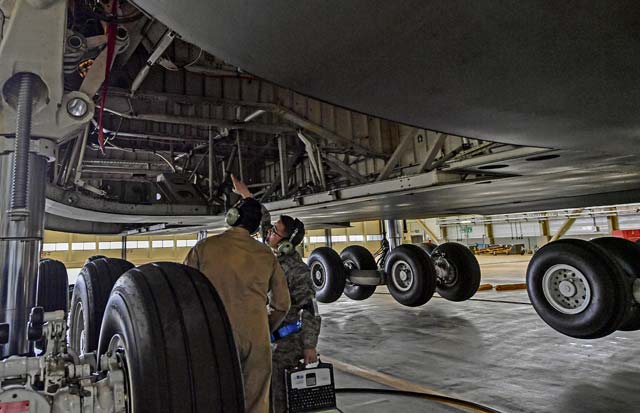
Normally when a C-5M Galaxy is off the ground, it is soaring thousands of feet above the world. For one particular C-5 flying out of Travis Air Force Base, Calif., that was not the case when a malfunctioning landing gear caused it to be raised only a few feet above the ground inside a hangar.
“We were coming down to land, the pilots threw the gear down and the number four main landing gear did not extend, so they had to emergency extend it,” said Staff Sgt. Cesar Mardirossian, 60th Aircraft Maintenance Squadron flying crew chief. “We were able to land safely and we had to jack the aircraft.”
Mardirossian worked alongside Airmen assigned to the 721 AMXS to jack, inspect, and repair the aircraft’s landing gear.
“When it came down, we towed it onto its spot to make sure everything was still good,” said Staff Sgt. Brian Crea, 721 AMXS airlift specialist mission maintenance craftsman. “We got it outside the hangar, did our inspection on it to make sure everything was good, and prepared everything to tow it into the hangar and jack it up.”
The C-5 required six fuselage jacks to hold it, two in the nose, two in the middle, and two in the aft. Each jack is capable of holding 60 tons, over all providing support for 720,000 pounds. A typical C-5 weighs 415,000 pounds, but six jacks were used for stability.

Upon inspection, the 721 AMXS and 60 AMXS Airmen determined the landing gear needed a new handle. They installed it and proceeded to perform a function check on every gear. For a C-5, the nose landing gear is allowed 20 seconds each to extend and retract, while the remaining four gears are allowed 22 seconds to extend and 17 to contract.
“Primarily we were concerned about the number four gear, but because it’s a new handle we are required to do a gear swing in every single gear,” Crea said. “Because it’s a C-5, we’re only supposed to do one gear at a time for safety purposes. We swung the gears and everything checked out. They met all the time limits.”
The next step was to check the caster function, which allows gears to turn left or right, for the nose and aft gears. They turned the nose gear to extreme left and right, and the two back gears were turned left, centerand right simultaneously and individually to ensure they could reach the required 20 degrees.

“They came to center. They castered. Everything was good, and they worked in unison. Nothing was stuttering,” Crea said. “Up to this point, we have no reason to believe the aircraft is not serviceable anymore.”
It has been over a year since the 721 AMXS has had a C-5 raised on a full fuselage jack.
“It’s always amazing to see the things we do,” Crea said. “We lifted this huge aircraft off the ground, and now we’re going to swing the gears and everything is going to shake, and it’s going to stay up.
“It was a great experience,” he continued. “This was my second gear swing on my own, so I was a little nervous, but I was also confident and I had good training. I have very good mentors. We ran through a lot of stuff with a lot of good people, so I was comfortable with the task we were doing.”
Through the combined experience of the pilots, flying crew chief, and maintainers from Travis and Ramstein, they were able to make a safe landing and tow, jack, inspect, and repair a C-5’s malfunctioned landing gear together.



